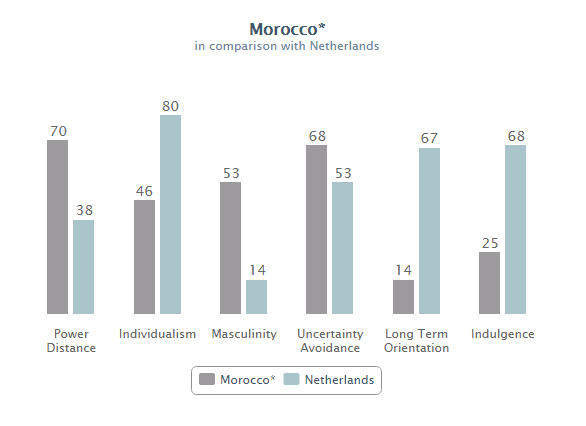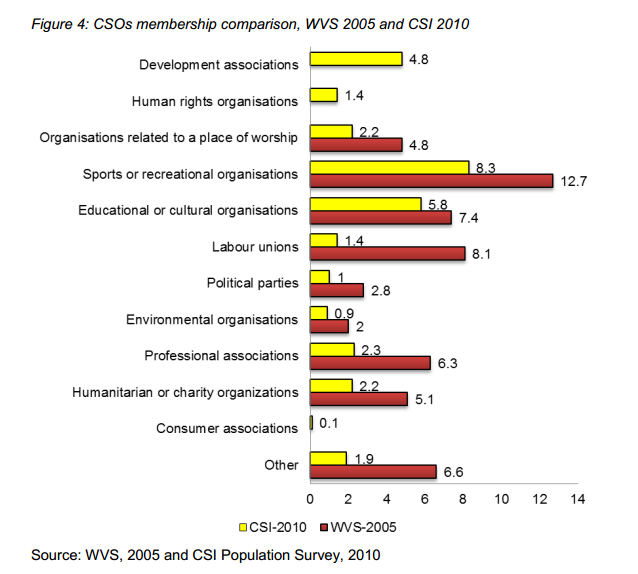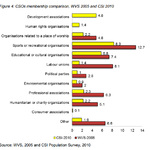Cultural Analysis
A cultural analysis of Morocco, based on the ten cultural dimensions, created by Trompenaars (2001), is made. Hofstede (Geert-hofstede.com, 2015) also mentions the cultural dimension of long term orientation.
In this graph cultural dimensions of Morocco are ranked and compared with these of the Netherlands (Geert-hofstede.com, 2015). The assigned scores are partially based on assumptions derived from data representing similar countries in combination with practitioner experience.
We can see that Morocco is, with a score of 70, a hierarchical society. Everybody has a place in the hierarchical order and this needs no further justification. This reflects inequalities, centralization and the fact that subordinates expect to be told what to do (Geert-hofstede.com, 2015). In contrast, the Netherlands is far more orientated on equality, where everyone has a contribution and people don’t particularly like to be told what to do.
Regarding the cultural dimension of individualism, we can note that Morocco is a highly collectivistic country, where people live in groups. This corresponds to the importance of family relationships in Morocco. In the Netherlands, we are more individualistic.
Also, Morocco is more masculine than the Netherlands. Firstly, this is due to the fact that the Netherlands is a welfare state, every citizen is obliged to have a health insurance and some people receive care allowance. Also, public health services are available for everyone and distributed well throughout the country. The access to health services is worse in Morocco, especially in highly rural areas. Secondly, the division of tasks between men and women is more fixed in Morocco, women have less rights than men, whereas in the Netherlands men and women are equal.
Another big difference between Morocco and the Netherlands relates to the degree of long term orientation. In Morocco, people are generally not long-term orientated. Whereas in the Netherlands it is far more common to think of the future.
Which dimensions are enablers for the project and which are barriers? And how to take account of these in our project work?
These said differences in cultural dimensions between Morocco and the Netherlands can influence our project in a positive or negative way. For instance, we have to take the hierarchical structure of Moroccan society into account, as this may lead to only a small input from people who consider themselves as subordinates, although we strive for an equal relationship.
Secondly the differences between men and women is also something we should adapt to, as we are used to being fully equal to men, but in Morocco there are clear restrictions on how to behave as a woman. The last dimension that can have a negative influence on the project is the low level of long term orientation in Morocco, as the mission of the product is one that can only be achieved within a long time span. Thus we have to put extra effort in explaining the long-time problems of cooking on wood fires.
On the other hand there’s also a dimension that can be an enabler for our project, namely the collectivistic character of Morocco. As our project lays within the domain of cooking, the fact that family relationships are important contributes to the importance of eating together. Thus, cooking plays a big role in the daily life of Moroccan and therefore it’s more likely they are open-minded towards improvements on this subject.
An eleventh dimension to those of Trompenaars, was added by Kroesen (2014):
11. Civil Society:
“Regrouping of individuals and organizations independent of family loyalty and state authority”
Akesbi (2011) analysed numerous Civil Society Organizations (CSOs), ten types of organizations were identified, which are divided in the following ten categories: (NB: all organizations with political are excluded)
1. Human rights and advocacy organisations
2. Development and services organisations
3. Educational and cultural organisations
4. Labour unions
5. Church or religious organisations
6. Social movements
7. Zawayat (religious brotherhood)
8. Private media
9. Professional associations
10. Foundations
Only a small percentage of the whole population is member of a Civil Society Organization, non-members take up 91,7 to 99,9 percent of the surveyed population, depending on the type of organization. (Akesbi, 2011)
In the graph below, we notice a reduction of membership rates in each category, surveyed by the CSI (Civil Society Index) in 2010 and the World Values Survey in 2005. According to the respondents of the survey, this is due to bad time management, meetings at inappropriate hours that last too long and inefficiency. (Akesbi, 2011) Thus, civic engagement has an environment that sometimes sabotages participation. In order to encourage civic engagement and to ensure that memberships will last longer, structural reforms in Civil Society Organizations are needed.
To encourage engagement and thereby strengthen Civil Society Organizations, new members should be attracted as well. According the survey, the leading factors to participate are ‘defending rights’(49,1%), intellectual interest (31,8%) and interaction with other people (27,1%).
Other factors are financial interest and, though marginally, political interest. (Akesbi, 2011)
One should respond to this factors by for example encouraging the need to defend one’s rights.
Important for our project and what could be a problem, is the relatively low amount of human rights organizations and environmental organisations. The first one is important concerning women’s rights to for example work or do other things beside the housekeeping and care of the children. Because one of the results of using the Fortune Cooker is that woman will have more time, it is essential that society gives them opportunities to use this time for different purposes. Otherwise there could be no use in utilizing the Fortune Cooker, as they have more than enough time that they may only spend on housekeeping and the care of the children. Secondly, growth of environmental organizations is of major importance for our project and its continuation, as such growth can achieve more awareness of environmental problems under the local society, which is essential to convince (future) customer segments of the benefits of the Fortune Cooker.
Sources
Akesbi, A. (2011). Civil Society Index for Morocco. Analytical Country Report. International Version.
CIVICUS, Espace Associatif. Retrieved from: http://www.espaceassociatif.ma/IMG/pdf/Morocco_ACR.pdf
Geert-hofstede.com,. (2015). Morocco - Geert Hofstede. Retrieved 29 October 2015, from http://geert-hofstede.com/morocco.html
Kroesen, O. (2014). Planetary Responsibility: An Ethics of Timing. Wipf and Stock.
Trompenaars, F., Hampden-Turner, C. (2001). Over de Grenzen van Cultuur en Management. Business Contract.



